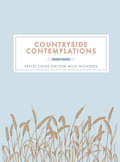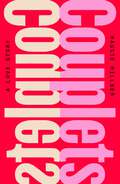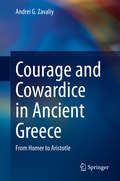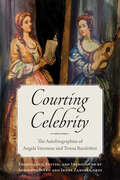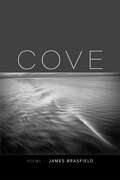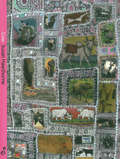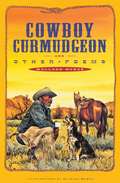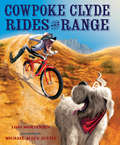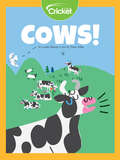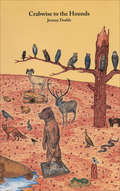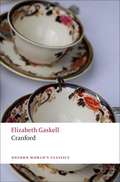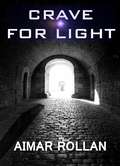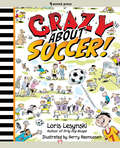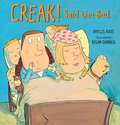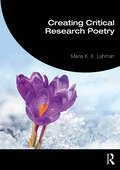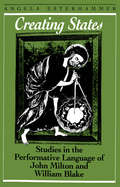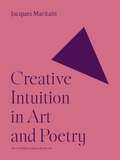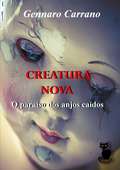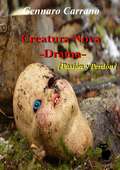- Table View
- List View
Countryside Contemplations: Reflections on Our Wild Wonders
by Trigger'In the spring, at the end of the day, you should smell like dirt.' - Margaret Atwood. This beautifully packaged book offers a rare opportunity to slow down, step back and to receive the natural restorative power of nature through its beautiful, evocative passages and quotes inspired by the countryside. The contemplative words will transport you to a space of quiet reflection as you simply sit and be. 'Soon will the high Midsummer prompts come in Soon will the musk carnations break and swell Soon shall we have gold-dusted snapdragon Sweet-William with his homely cottage-smell And stocks in fragrant blow Roses that down the alleys shine afar And open, jasmine-muffled lattices'...Mathew Arnold, Thyrisis: A Monody to Commemorate the Author's Friend, Arthur Hugh Clough
Couplets: A Love Story
by Maggie Millner“An astounding debut.”—Adrienne Raphel, The New York Times Book ReviewA dazzling love story in poems about one woman’s coming-out, coming-of-age, and coming undoneA woman lives an ordinary life in Brooklyn. She has a boyfriend. They share a cat. She writes poems in the prevailing style. She also has dreams: of being seduced by a throng of older women, of kissing a friend in a dorm-room closet. But the dreams are private, not real.One night, she meets another woman at a bar, and an escape hatch swings open in the floor of her life. She falls into a consuming affair—into queerness, polyamory, kink, power and loss, humiliation and freedom, and an enormous surge of desire that lets her leave herself behind.Maggie Millner’s captivating, seductive debut is a love story in poems that explores obsession, gender, identity, and the art and act of literary transformation. In rhyming couplets and prose vignettes, Couplets chronicles the strictures, structures, and pitfalls of relationships—the mirroring, the pleasing, the small jealousies and disappointments—and how the people we love can show us who we truly are."An endlessly inventive, wise, exhilarating book.”—Garth Greenwell, author of Cleanness and What Belongs to You
Courage and Cowardice in Ancient Greece: From Homer to Aristotle
by Andrei G. ZavaliyThe book offers the first comprehensive account of the debate on true courage as it was raging in ancient Greece, from the times when the immensely influential Homeric epics, the Iliad and the Odyssey, were composed, to the period of the equally influential author, Aristotle. The many voices that contribute to this debate include poets, authors of ancient dramas and comedies, historians, politicians and philosophers. The book traces the origin of the earliest ideal of a courageous hero in the epic poems of Homer (8th century BCE), and faithfully records its transformations in later authors, which range from an emphatic denial of the Homeric standards of courage (as in comedies of Aristophanes and some Dialogues of Plato) to the strong revisionist tendencies of Aristotle, who attempts to restore genuine courage to its traditional place as an exclusively martial, male virtue.Without attempting to cover the whole of the Western history, the book is able to explore the most important primary Greek sources on the subject matter in greater details, and provide the reader with a comprehensive picture of the changes in both popular and philosophical conceptualizations of the standards of courage from the Archaic period to the middle of the 4th century BCE. A deeper understanding of the history of the debate on courage should help to shape the modern discussions as well, as it becomes obvious that many of the questions on courage and cowardice that are still raised by the contemporary authors from different fields, have been thoroughly considered during the early stages of Greek culture. The book seeks to undermine a common stereotype of a single, unified view on courage and cowardice in Ancient Greece and shows that the current debates on what constitutes genuine courageous character can be traced to the various direct and indirect discussions on this subject matter by the ancient authorities.
Courting Celebrity: The Autobiographies of Angela Veronese and Teresa Bandettini (Toronto Italian Studies)
by Adrienne Ward Irene Zanini-CordiIn 1826 Angela Veronese, a gardener’s daughter, wrote and published the first modern autobiography by an Italian woman. Veronese’s account focuses on her unique experience as a peasant girl who came of age among the Venetian elite, and details how she attained a certain renown in and out of Italy by improvising, writing, and publishing her own lyrics. Courting Celebrity is a bilingual annotated edition of Veronese’s autobiography. To better elucidate Veronese’s thinking, the book includes the autobiographical writing of another contemporary Italian poet, Teresa Bandettini, a well-known Tuscan poet-improviser. The book offers a substantial sample of Veronese’s poems, translated and in the original. These compositions, together with detailed bibliographical documentation, point to the success of Veronese’s autobiographical enterprise and offer an unparalleled view of both high society and popular culture at the time. Courting Celebrity illustrates women’s practice in two key literary genres, poetry and autobiography, and illuminates the strategies of women’s self-fashioning and pursuit of celebrity.
Cove: Poems
by James BrasfieldIn Cove, the compulsive intensity with which James Brasfield seeks to capture a fleeting moment’s imagery, “to choose a song sown / for the moment,” imbues his poems with a sense of urgency and movement. By exploring the translation of the sensory world into art, Brasfield faces the passage of time and the transitory nature of experience, thought, and memory. The poems find “angles of vision” to rescue a present instant in its essential fluidity, to go deep enough, without distraction, into the moment and reveal touchstones of being. Throughout Cove, Brasfield embraces the enduring effort to create an experience of language that is rich, lasting, and true, as life speeds into and through the future.
Cow
by Susan HawthorneAn intriguing approach to the rewriting of myth, this poetry collection journeys through the history of languages and symbolic traditions. Through main character Queenie, a cow of many abilities, these poems delve into the creation of the universe as Queenie fashions the galaxies and travels through the sky as a herd of stars. Delightful and surprising, this compilation draws on the Greek lyric tradition of Sappho as well as on South India's Sangam poetry tradition to provide a balanced work of both humor and melancholy.
Cowboy Curmudgeon And Other Poems
by Wallace Mcrae Clinton McraeWally McRae, a regularly featured performer at the annual Cowboy Poetry Gathering in Elko, has performed on a syndicated television program and at the National Cowboy Hall of Fame. He is the first cowboy poet to be granted a National Heritage Award. This book contains 94 of his poems, including such classics as "Reincarnation," along with 40 new poems published for the first time.
Cowley's Essays
by Abraham CowleyThe calm spirit of Cowley's "Essays" was in all his life. As he tells us in his Essay "On Myself," even when he was a very young boy at school, instead of running about on holidays and playing with his fellows, he was wont to steal from them and walk into the fields, either alone with a book or with some one companion, if he could find any of the same temper.
Cowpoke Clyde Rides the Range (Cowpoke Clyde)
by Lori Mortensen Michael Allen AustinCowpoke Clyde is plumb confused. An ad in his favorite catalog says he oughta buy a bike. But why should he do that? After all, he’s got a horse. Still, a bike wouldn’t buck or bite, and he wouldn’t have to feed it. He orders one, and when it comes, he mounts up and sets right off, wibble-wobblin’ down the road. Good thing he’s got his trusty friend Dawg to look out for him. Turns out learning to ride a bike is just a tad bit harder than he thought! With its rip-roaring rhyming text and turn-the-page revelations, this book is pure read-aloud fun.
Cows!
by Leslie SharpeCows in the meadow, cows on the hill, cows peeking over the windowsill! Babies and toddlers will enjoy this funny rhyming poem about the silly things cows do on their farm.
Crabwise to the Hounds
by Jeramy DoddsWinner of the Trillium Book Award for Poetry. Nominated for the Griffin Poetry Prize and the Gerald Lampert Award.With cameos by jackalopes, Glenn Gould, homemade spaceships and Carl Linnaeus, these poems are remarkable for their technical agility and their restless inventiveness. There's an elegance here that matches Dodds' impulse to challenge the reader with fresh metaphor and astonishing phrasing; the formal ambitions of many of the poems in Crabwise to the Hounds are balanced by an inclination towards wordplay and a bright musicality. Humorous at times, yet always handled with consummate craft, these poems invoke historical figures like Hiram Bingham and Ho Chi Minh even as they traverse a poetic landscape that includes telephone-game-style translations, interpretive dance poems on historic paintings and carnivalesque jaunts into a natural world overrun with mules, Alsatians, lions, and motorcycle-sized-deer.
Cranford
by Elizabeth Cleghorn GaskellA portrait of the residents of an English country town in the mid nineteenth century, Cranford relates the adventures of Miss Matty and Miss Deborah, two middle-aged spinster sisters striving to live with dignity in reduced circumstances. Through a series of vignettes, Elizabeth Gaskell portrays a community governed by old-fashioned habits and dominated by friendships between women. Her wry account of rural life is undercut, however, by tragedy in its depiction of such troubling events as Matty's bankruptcy, the violent death of Captain Brown or the unwitting cruelty of Peter Jenkyns. Written with acute observation, Cranford is by turns affectionate, moving and darkly satirical.
Crash's Law: Poems
by Karen VolkmanSelected by Heather McHugh as 1995 winner in the National Poetry Series, Volkman's debut collection retells myths and fairy tales in a modern, abstract voice to reveal essential, nearly private messages. In "Persephone at Home," for example, the abducted goddess is ironic and cold in accepting her fate: "I'll give no prince to this kingdom./ That thing is dead." The collection's pared-down yet inventive voice often surprises with exact rightness, as in "Reflections": "What good is a sky, I might have asked, if it will not give us new/ blue distance, if it will/ only throw our loss back at us, shabby lens." Like the girl in "Science and Industry" who chooses to play with Legos rather than "sweet-limbed cherry-cheeked/ dolls," Volkman chooses an angular, rigorously constructed style that informs her work with an exciting confidence, even though at times substance or a more radical exploration of meaning is sacrificed to style. Despite this occasional hollow effect, Volkman forcefully fuses ancient story and contemporary scene to frame an ironic and deflected commentary on modern emotional life.
Crave for light
by Aimar RollanFor the Sufis, there is no greater punishment than to feel nostalgic for being separated from the source, nor greater reward than to feel attached to it. Thus, the emotion that predominates in this work is nostalgia, and its consequent yearning to break free from it and merge into Unity. This is the story of a fall, a loss, a recovery and an ascension. It is the story of a search for light from the deepest darkness. It is written in poetic prose, with brief fragments independent of each other, which can be read in isolation, but that have a certain cohesion, since each fragment carries, or craves, a little more light than the previous one. It is about a man who has lost his light, but who harbors a faint flash of memory of her. That transience tortures his mind and makes him embark on a path of ascension to recover that precious treasure. It goes through all phases of depression, sadness and melancholy, rejoicing in its loss. In the initial phases he identifies that lost light with the love of a woman, with the love of many women who are one for him; and the loss of that love is the germ of his melancholy. As he progresses in his tribulation, he recognizes that this yearned light belongs to something more subtle and deep, to the realm of his soul... He recognizes that emotional pain comes from feeling separated from the primordial source. This work is written in a somber language, but in its background aims to convey beauty, hope and joy.
Crazy About Soccer
by Loris Lesynski Gerry RasmussenThis new collection of poems by Loris Lesynski captures the joys, thrills, and challenges of one of the most popular sports in the schoolyard today. Rhythmic, funny verses reflect the game's energy while offering sound suggestions for proper play.
Creak! Said the Bed
by Phyllis RootIT'S THE MIDDLE OF THE NIGHT. Everyone is cozy and tucked up in bed when out of the darkness, SQUEAK, says the door. Mama's eyes fly open. Who's out of bed? Is it Evie? Ivy? Little Mo? On this stormy night in their little house, only Papa keeps snoring away -- Snurfle, Snark -- unaware of the wild weather outside and the growing number of nervous bedmates inside. Will anything wake Papa? CREAK, said the bed. A preposterous series of events takes readers barreling toward bedlam in this delicious read-aloud.
Creating Critical Research Poetry
by Maria K. LahmanCreating Critical Research Poetry critically engages with the ways in which researchers can poetically approach textual representations that narrate the unnarratable and contest the uncontested.This text provides a rich path for early research poets to engage with and bloom and established research poets to dig deeper and flourish.Connections to literary poetry and critical social science theories are detailed. First-person poetic accounts where poets describe early fruitful engagement with poetic forms are highlighted. Free verse, formed poetry, and dimensional poems (e.g. concrete poetry) are covered in depth, with guidance for developing a poetic sensibility and honing research poetry craft. Poetic experiences are integrated throughout the book, which may be engaged with individually, as a group, and in virtual or face-to-face courses.Each chapter provides reflexive questions for the reader to engage with in their own journal writings, a poem creation exercise, and further poetic resources. Set within critical theories, Creating Critical Research Poetry provides a context for early research poets, and thought-provoking possibilities for seasoned research poets. This is the perfect entry point to this burgeoning field of critical inquiry and qualitative research.
Creating Romantic Obsession: Scorpions in the Mind (Palgrave Studies in Literature, Science and Medicine)
by Kathleen Béres RogersMost of us have, at one time, been obsessed with something, but how did obsession become a mental illness? This book examines literary, medical, and philosophical texts to argue that what we call obsession became a disease in the Romantic era and reflects the era’s anxieties. Using a number of literary texts, some well-known (like Mary Shelley’s 1818 Frankenstein and Edgar Allan Poe’s 1843 “The Tell Tale Heart”) and some not (like Charlotte Dacre’s 1811 The Passions and Charles Brockden Brown’s 1787 Edgar Huntly), the book looks at “vigilia”, an overly intense curiosity, “intellectual monomania”, an obsession with study, “nymphomania” and “erotomania”, gendered forms of desire, “revolutiana”, an obsession with sublime violence and military service, and “ideality,” an obsession with an idea. The coda argues that traces of these Romantic constructs can be seen in popular accounts of obsession today.
Creating States: Studies in the Performative Language of John Milton and William Blake
by Angela EsterhammerAlthough the concept of the performative has influenced literary theory in numerous ways, this book represents one of the first full-length studies of performative language in literary texts. Creating States examines the visionary poetry of John Milton and William Blake, using a critical approach based on principles of speech-act theory as articulated by J.L. Austin, John Searle, and Emile Benveniste. Angela Esterhammer proposes a new way of understanding the relationship between these two poets, while at the same time evaluating the role of speech-act philosophy in the reading of visionary poetry and Romantic literature. Esterhammer distinguishes between the 'sociopolitical performative,' the speech act which is defined by a societal context and derives power from institutional authority, and the `phenomenological performative,' language which is invested with the power to posit or create because of the individual will and consciousness of the speaker. Analysing texts such as The Reason of Church-Government, Paradise Lost, The Marriage of Heaven and Hell, and Jerusalem, Esterhammer traces the parallel evolution of Milton and Blake from writers of political and anti-prelatical tracts to poets who, having failed in their attempts to alter historical circumstances through a direct address to their contemporaries, reaffirm their faith in individual visionary consciousness and the creative word – while continuing to use the forms of a socially or politically performative language.
Creative Intuition in Art and Poetry (The A. W. Mellon Lectures in the Fine Arts #1)
by Jacques MaritainThe classic work on the sublime interplay between the arts and poeticsThis book explores the rich and complex relationship between art and poetry, shedding invaluable light on what makes each art form unique yet wholly interdependent. Jacques Maritain insists on the part played by the intellect as well as the imagination, showing how poetry has its source in the preconceptual activity of the rational mind. As Maritain argues, intellect is not merely logical and conceptual reason. Rather, it carries on an exceedingly more profound and obscure life, one that is revealed to us as we seek to penetrate the hidden recesses of poetic and artistic activity. Incisive and authoritative, this illuminating book is the product of a lifelong reflection on the meaning of artistic expression in all its varied forms.
Creatura Nova
by Gennaro CarranoA Imolada, A Gentil, Sensibilidade, Delicado, Eros, Pálida. Uma jornada poética para descobrir as várias facetas da alma humana, onde o bem é confundido com o mal, o amor se funde com ódio, o perdão se torna culpa. Qual o limite entre o certo e o errado? A consciência será realmente um juiz imparcial? Será a moralidade apenas um condicionamento social? Uma eterna luta entre o instinto e a razão... A Creatura Nova pretende, através do estilo e da temática, representar uma nova maneira de fazer poesia. Um estilo antigo que se fundiu com temas atuais e métodos modernos. Mais do qu com uma antologia, deparamo-nos com uma narrativa poética real. Pela primeira vez, um tema difícil, como o estupro incestuoso, é tratado na poesia. As principais temáticas são as facetas da alma humana, vistas sob vários pontos de vista. E 'dividido em 'capítulos': "A Imolada" e "A Gentil" são o âmago da narrativa poética, onde é narrada a história de Adelfo (do grego = adelphos irmão) que estupra a irmã Verginia. Esta vai encontrar forças para perdoá-lo mas também o perdão se pode tornar uma grande culpa, e serão essa, de fato, que elouquecerá o protagonista Adelfo. Outra peculiaridade são os narradores. Em "A Imolada", os dois primeiros poemas são narradas por um narrador externo e os dois últimos do ponto de vista interno, ou seja, o de Adelfo. A mesma coisa acontece no capítulo "A Gentil", onde nos dois primeiros poemas o narrador é externo e nos dois últimos é interno, isto é, temos o ponto de vista da irmã Verginia. Isso possibilita olhar para a história, para o carrasco e a vítima de diferrentes perpectivas. No momento em que os seus papéis se misturam, a vítima torna-se carrasco e o carrasco, vítima. Nos oito poemas está presente um elemento commum: o lírio, um símbolo de pureza. Os restantes, sempre divididas por tema, tratam de temas como o amor a Deus, erotismo, autoflagelação, feminicídio e abandono.
Creatura Nova La magnificence des âmes brisées
by Sonia Broyart Gennaro CarranoL'Immolata, la Gentile, Sensibilitade, Delicato, L'Eros, Pallida. Un voyage poétique à la recherche des différentes facettes de l'âme humaine où le bien et le mal, l'amour et la haine se confondent, où le pardon devient culpabilité. Où se trouve la frontière entre ce qui est juste et ce qui ne l'est pas ? La conscience est-elle réellement un jugement impartial ? La morale est-elle seulement un conditionnement de la société ? Une lutte éternelle entre instinct et raison... " Con Rassegnatio Et Assolutio Tollereresti Un Riprovevole Atto?" " Nell'Odiar Vivrei Angustiato!"
Creatura Nova - El Renacimiento de la Mariposa
by Roberto Carlos Pavón Carreón Gennaro CarranoLa Inmolada, la Gentil, Sensibilidad, Delicado, El Eros, Pálida. Un viaje poético al descubrimiento de las diversas facetas del alma humana, donde el bien se confunde con el mal, le amor se funde con el odio, el perdón se vuelve una culpa ¿Cuál es la frontera entre lo que es justo y lo que es incorrecto? ¿La conciencia es en verdad un juez imparcial? ¿La moral es únicamente un condicionamiento social? Una eterna lucha entre instinto y razón... " Con Rassegnatio Et Assolutio Tollereresti Un Riprovevole Atto?" " Nell'Odiar Vivrei Angustiato!" Criatura Nueva quiere por estilo y temática representar un modo nuevo de hacer poesía. Un estilo antiguo fusionado con temáticas actuales y modalidad modernas. Nos enfrentamos, de hecho, más que a una compilación a una verdadera y propia narrativa poética. Por primera vez viene afrontado en poesía un tema escabroso como el estupro incestuoso. Las temáticas principales son las facetas del alma humana, vistos bajo varios puntos de vista. Está subdividido en "capítulos": La Inmolada y la Gentil son el verdadero y propio fulcro de la narración poética, de donde viene la historia de Adelfo (del griego adelphos = hermano) que viola a la hermana Virginia, ella encontrará la fuerza para perdonarlo aunque el perdón también puede ser una gran culpa, será esto, de hecho, lo que hará enloquecer al protagonista Adelfo. Otra particularidad son los narradores en la Inmolada tenemos las primeras dos poesías narradas por un narrador externo y las últimas 2 desde el punto de vista interno, es decir el de Adelfo. Lo mismo sucede en los capítulos de "La Gentil", donde en las primeras 2 poesías, el narrador es externo y en las últimas dos es interno, o sea tenemos el punto de vista de la hermana Virginia. Es un modo para ver con varios ojos y bajo varios aspectos, la historia, el carnicero y víctima, a medida que estos papeles se mezclan, la
Creatura Nova: Pasión y perdón
by Gennaro CarranoAtemporal drama en el que autor Gennaro Carrano nos muestra los polos opuestos del ser humano: la extrema maldad y la bondad absoluta y cuyo final soprenderá al lector por la crudeza de los hechos. La historia proviene de una época lejana y de un lugar que bien podría estar más cercano de lo que imaginamos. Dos hombres nos la traen, tan distantes entre sí como el tiempo y el lugar del mismo. Felice, poeta de la alta sociedad y Valerio, un hombre sencillo. El impulso de contarla surge de un sentimiento vacilante, el deseo de comunicar la deriva de sentimientos ignorados y el impulso de deshacerse de una pesada carga. Dos hermanos son los protagonistas de la historia: Verginia y Adelfo. La miseria, la soledad, la ignorancia, la ira y la frustración pueden ser una mezcla explosiva para cualquier hombre que no esté acostumbrado a verse por dentro.
